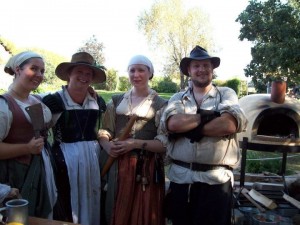This past weekend, September 1-3, 2012 was the Mideast Mirage weekend at the Minnesota Renaissance Festival. We struggled through the long weekend with the excessive heat, but we overcame it and made very tasty recipes. Our 12:30 show centered on our wood-fired oven that was funded through Kickstarter. The campaign concluded on July 1, 2012.

Each recipe we use is tested and altered to suit our needs. The recipes below are the perfected versions of our recipes.
Ingredients
2 lbs. skinless chicken thighs with bones
1 tsp saffron
1 tbsp hot water
1 cup onion, chopped
1” x 1” fresh ginger, minced
3 cloves of garlic, minced
1 tsp cumin seed
3/4 tsp coriander seed
1/8 fresh ground nutmeg
1/4 tsp chilies
3/4 tsp salt
2 tsp paprika
3/4 tsp turmeric
1/2 a lime, zested and juiced
1 tsp olive oil
2 tsp of Punjab powder (1 tsp cinnamon powder, 1/2 tsp ground cloves,
3/4 tsp of black pepper, 1/4 tsp ground cardamom)
1 and 1/2 cup of unflavored Greek yogurt
1/4 cup melted butter or ghee
Preparing the marinade:
Crush the saffron with your fingers and add to hot water and set aside for 10 minutes. Place whole seeds in a mortar and pestle or grinder and break them down to a course powder. Mix the crushed spices with the powdered spices and mix in with the yogurt, saffron water, onions, garlic, ginger, lime juice and zest, oil and yogurt and mix until creamy.
Cooking:
With a sharp knife cut deep crosses into the tops and bottoms of each piece of chicken. Add the chicken to the marinade and transfer to a ceramic or glass bowl. Let it sit in the refrigerator for 4-24 hours. The longer it marinades, the better the flavor.
When ready, preheat oven to 425º F and remove the chicken from marinade and place the chicken in a single layer in a shallow, ceramic dish. Discard Marinate. Bake for 15 minutes and baste the chicken with the butter/ghee and bake for another 10-15 minute or until the chicken is cooked thoroughly.
NAAN
1 package active dry yeast (or, if from bulk, 2 teaspoons yeast)
1 cup warm water
¼ cup white sugar
3 tablespoons milk
1 whole egg, beaten
2 teaspoons salt
4½ cups bread flour
2 teaspoons minced garlic (optional)
¼ cup butter (one half stick), melted
In a large bowl, dissolve yeast in warm water and let it stand about 5 minutes. Add the sugar to the yeast water and let it sit for a couple of minutes. The sugar will help feed the yeast. Stir in milk, egg, salt, and enough flour to make a soft dough. Knead for 6 to 8 minutes on a lightly floured surface, or until smooth. Place dough in a well oiled bowl, cover with a damp cloth, and set aside to rise. Let it rise 1 hour, until the dough has doubled in volume.
Punch down dough and pinch off small handfuls of dough about the size of a golf ball. Roll into balls, and place on a tray. Cover with a towel, and allow to rise until doubled in size, about 30 minutes. The oven should have the fire removed and the temperature stabilized around 700 to 900 degrees F.
At oven side, roll balls of dough out into thin circles. Use your rolling-pin to roll in the minced garlic into the naan and brush with butter. Place dough on hearth, and cook until puffy and lightly browned. Brush uncooked side with butter, and turn over. Cook until browned (about 45 seconds in a 900 degree oven). Remove from hearth, and continue the process until all the naan have been prepared.
Now, if you do not have the advantage of a wood-fired oven, you may do a couple of things instead. You may use a pizza stone in the middle of the oven and heat your oven to 500 degrees. This will take longer, but will offer an adequate way of baking the naan. Naan may also be baked in a cast iron fry pan on high temperature. My assistant Rissa has used the back part of a pan as it is flat and easier to flip the naan.

